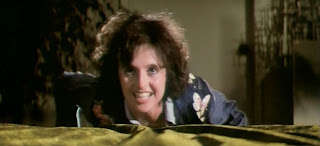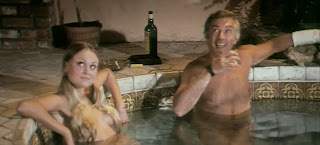Numerology is very important in divination, and few numbers send a shiver down the spine that our unlucky friend itself: the number 13. Which is why, friends, I always review 13 horror films during October. But as a prelude to this evening’s film, let’s consider a less immediately auspicious number: 72. That’s how many titles were on the DPP’s list during the UK video nasties controversy, itself as fine an act of spell-casting as any witch could hope for and requiring neither wolfsbane nor eye of newt. Requiring, in fact, only a few acres of newsprint and an infinitely gullible public.
I’ve seen quite a few of the 72 titles on said list – 39 were successfully prosecuted for obscenity, the others were guilty by association – and many of them have led me to a sad but inescapable conclusion: membership of the video nasties club doesn’t necessarily make a film nasty. In fact, a lot of them – ‘The Mardi Gras Massacre’ and ‘Anthrophagus: The Beast’ spring immediately to mind – are downright boring.
Of course, there are bona fide works of visceral nastiness to be found – a big round of applause, if you please, for ‘Cannibal Holocaust’: your flight attendant will be able to provide you with sick buckets – as well as a couple of items that flirt around the edges of the art-house camp, and one – Andrzej Zulawski’s ‘Possession’ – that belongs in said camp entirely.
But we’re here tonight, dear readers, to consider a film that strives to do something provocative and intelligent with its material while leaving one foot planted firmly, obstinately and defiantly in exploitation territory. ‘The Witch Who Came from the Sea’ is a curious work, directed by Matt Cimber, a man whose filmography tells its own story (‘Africanus Sexualis’, ‘Lady Cocoa’, ‘Alias Big Cherry’ and the Pia Zadora vehicle ‘Butterfly’), starring former Oscar nominee Millie Perkins as a sexually disturbed multiple murderess and written by her husband Robert Thom.
Thom was the writer of such lurid fare as ‘The Legend of Lylah Clare’, ‘Angel, Angel, Down We Go’, ‘Bloody Mama’ and ‘Death Race 2000’. Subtlety, we can immediate infer, was not one of his hallmarks. Perkins, too, is something of an eccentric talent. She made her debut in 1959 in the title role of George Stevens’s ‘The Diary of Anne Frank’ and picked up her Oscar nom in the process. TV work and small roles in the likes of ‘Ensign Pulver’ and ‘The Shooting’ occupied her for a decade or so. In 1974, she made an impression in Monte Hellman’s ever-so-slightly controversial ‘Cockfighter’, then two years later torn demonically into the lead role of ‘The Witch Who Came from the Sea’.
Which is where we came in.
Did that last sentence induce a bit of uncomfortable squirming? To watch the film is to squirm uncomfortably for an hour and twenty-eight minutes. There’s something “off” about ‘The Witch Who Came from the Sea’ from the start: the opening scene has Molly chaperoning her pre-teen nephews Tod and Tripoli at beach; one sibling has the other buried to his neck in sand while Molly gazes out across the light-fragmented waves and drones on dreamily about their sea captain grandfather, lost somewhere out there on the ocean and a fine man beloved of all.
And even before we learn that said individual was a slovenly pederast beloved of absolutely no-one, there’s something here that seems wrong. There’s a washed-out disconnectedness to the cinematography (by John Carpenter’s go-to guy Dean Cundey; a weirdness to the sound design; a woozy disjointedness to the editing. Images appear in negative, saturated with artificial colour.
The performances are all pitched at a slightly non-naturalistic level, from Perkins’s vacillations between wide-eyed child-like naivety to raging she-devil, to Vanessa Brown’s mounting hysteria as Molly’s sister Cathy, to Lonny Chapman’s grizzled scenery-chewing as Long John, owner to the nautical themed bar where Molly works. All of these actors, and the characters they inhabit, exist within the same fictive space and interact as if they’ve known each other for years, but there’s something about the way they play off each other – or maybe the way they don’t – that doesn’t quite gel. And I can’t for the life of me figure out whether Cimber achieved this deliberately or whether it was a happy accident. Happy because the all-pervading sense of “off-ness” is what gives ‘The Witch Who Came from the Sea’ its curious power.
What is undoubtedly purposeful – Thom’s screenplay fixates on it to an unsubtle yet entirely effective degree – is the film’s commentary on contemporary lives lived according to and in the shadow of the false promises and images of television. Molly is obsessed with TV, and the dividing line between men she can have a functional sexual relationship with (Long John) and those she vents her fury on is whether they are real or products of television. Two big set pieces – one running almost ten minutes – put Molly in almost fantasy-based situations with people she has seen and effused over on the small screen and it becomes swiftly apparent that they are no more real to her for suddenly being corporeal.
Naturally, a flashback to the young Molly’s horribly ruined life with her father culminates in a scene where a TV set is destroyed. Molly’s adult life, then, has been spent arranging the past into a fiction and hammering it into the tightly compacted and easily turned-off emotive space the size of a portable black & white TV.
Many of the video nasties, for all their blood-gouting, innard-spilling brutality, key into the gothic terrors of yesteryear – the mythic figure of the sasquatch in ‘Night of the Demon’, ritual sacrifices to a pagan idol in ‘The Mardi Gras Massacre’, the so-called savages of ‘Cannibal Holocaust’, the folkloric idea of a vengeful killer back from the dead in any number of slashers – but the nature of the nastiness in ‘The Witch Who Came from the Sea’, and the tropes and visual metaphors by which Molly’s descent into madness is mapped out, are strikingly contemporary.






































No comments:
Post a Comment